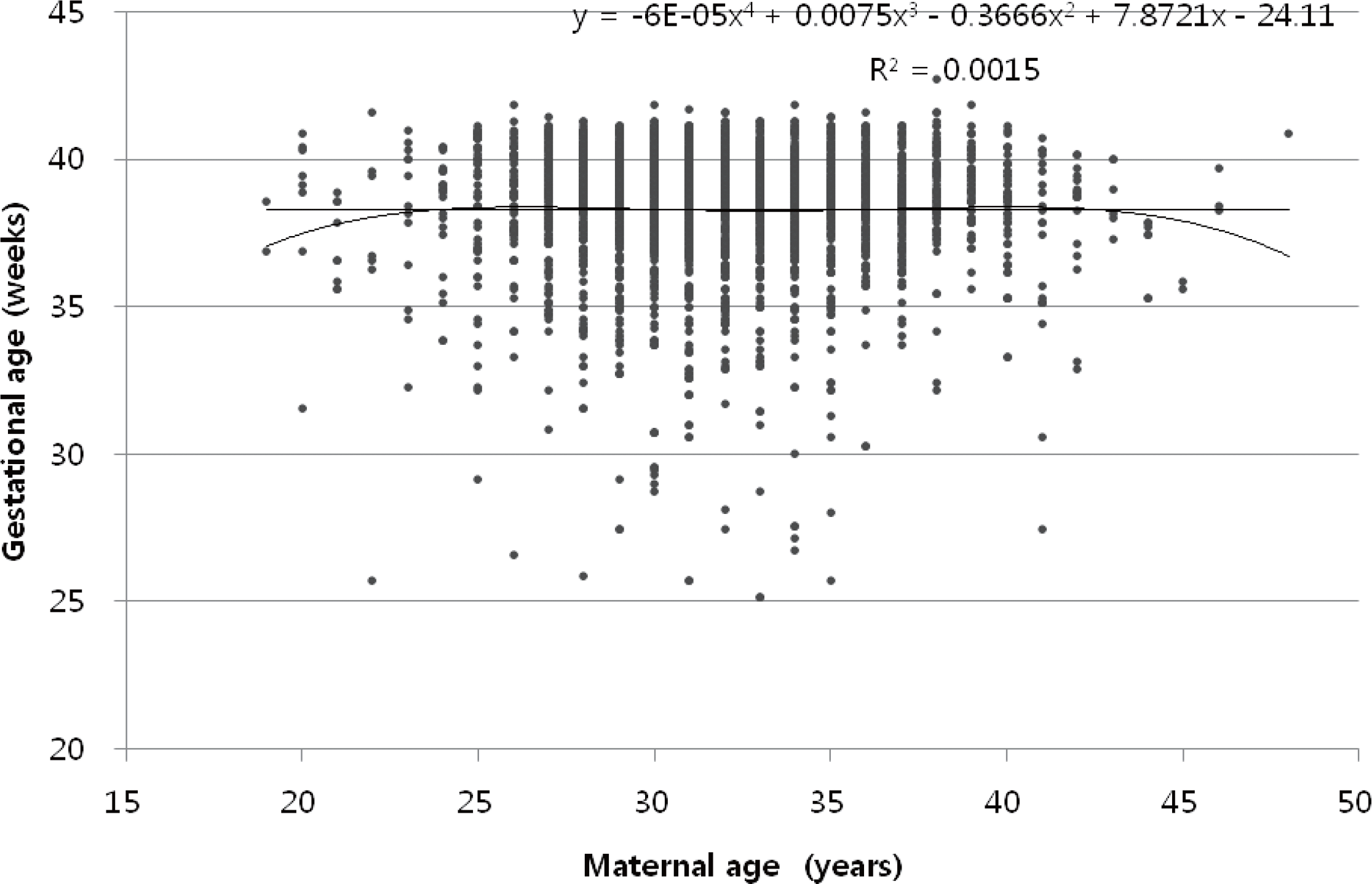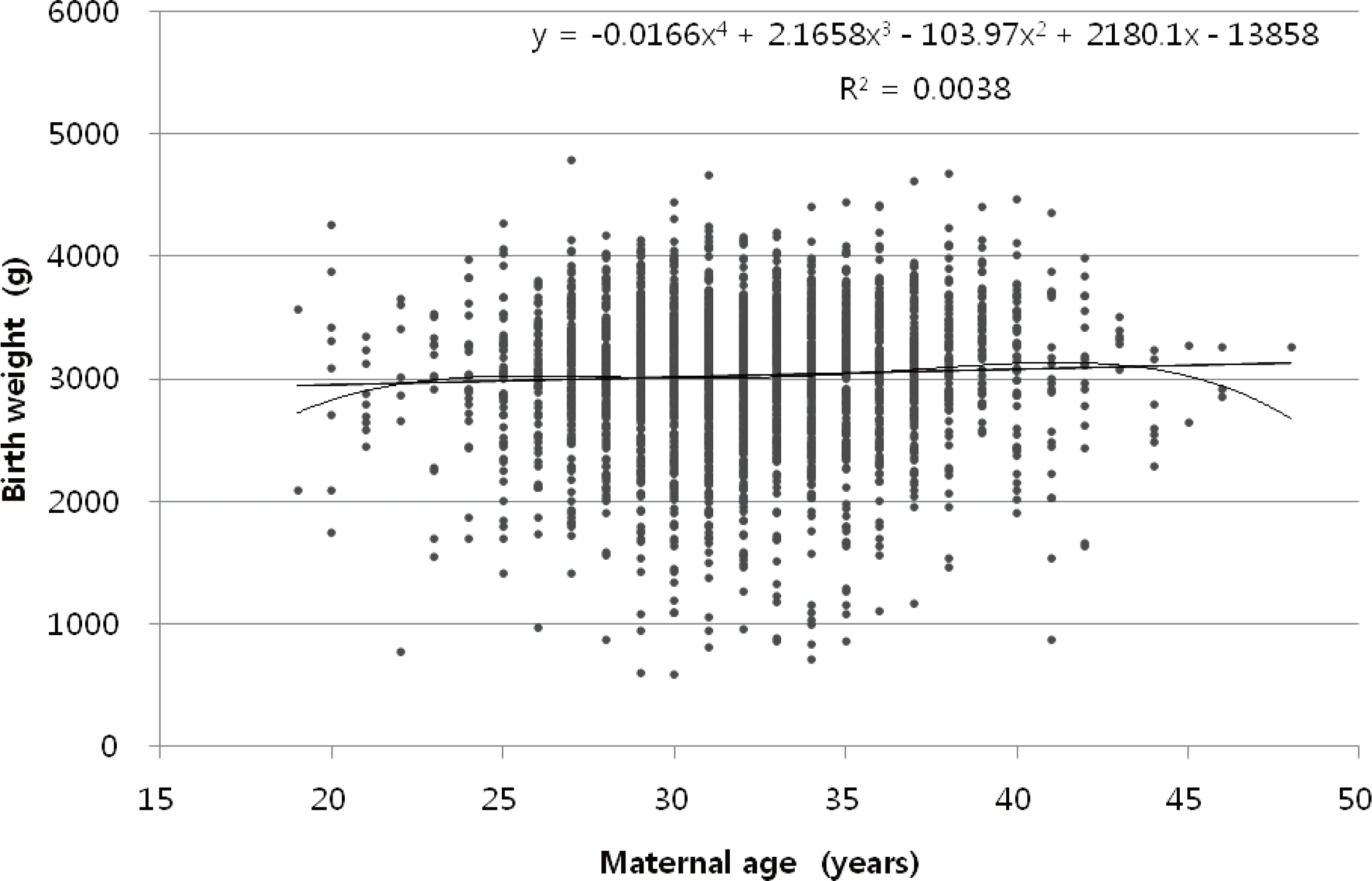Abstract
Purpose
This study aimed to compare the neonatal outcome by quantifying the effect of maternal age on low birth weight (LBW).
Methods
We reviewed the medical records of 12,742 newborn infants born at CHA Bundang Medical Center from January 2009 to December 2013. Infants were compared after being categorized by the following 4 maternal age groups - <25 years (N=343), 25-34 years (N=8,573), 35-39 years (N=3,186), ≥40 years (N=640). Statistical analysis included use of logistic regression models with likelihood ratio tests for interaction effects.
Results
Incidence of perinatal complications tended to increase significantly with maternal age - gestational diabetes mellitus (GDM;P<0.001), pregnancy induced hypertension (PIH;P=0.019), placenta previa (P<0.001), and cesarean section (P<0.001). Compared to the age group of 25-34 years (reference group), no significant differences were found in age group of 35-39 year [odds ratio (OR)=0.945, 95% confidence interval (CI) 0.847-1.056, P=0.319] and ≥40 years (OR=0.841, 95% CI 0.671-1.056, P=0.136) for LBW. After adjusted by gestational age, incidence of in vitro fertilization (IVF), and perinatal complications, maternal age was not found to be an independent risk factor for LBW (OR=0.847, 95% CI 0.730-0.982, P=0.028 for 35-39 years, and OR=0.652, 95% CI 0.481-0.884, P=0.006 for ≥40 years).
Conclusion
Although incidence of perinatal complications tends to increase with age, neonatal outcome of age group of ≥35 years measured by incidence of LBW infants was not unfavorable compared to the reference group. The result suggests that the thorough prenatal care may be more important than the maternal age itself.
REFERENCES
1.Mathews TJ., Hamilton BE. Mean age of mother, 1970-2000. Natl Vital Stat Rep. 2002. 51:1–13.
2.Kenny LC., Lavender T., McNamee R., O'Neill SM., Mills T., Khashan AS. Advanced maternal age and adverse pregnancy outcome: evidence from a large contemporary cohort. PLoS One. 2013. 8:e56583.

3.Klemetti R., Gissler M., Sainio S., Hemminki E. Associations of maternal age with maternity care use and birth outcomes in primiparous women: a comparison of results in 1991 and 2008 in Finland. BJOG. 2014. 121:356–62.

4.Wang Y., Tanbo T., Abyholm T., Henriksen T. The impact of advanced maternal age and parity on obstetric and perinatal outcomes in singleton gestations. Arch Gynecol Obstet. 2011. 284:31–7.

5.Korean National Statistical Office. Vital Statistics, Each year. Available from: URL:. http://kosis.nso.go.kr/Magazine/NEW/KP/KP01.xls.
6.Hansen JP. Older maternal age and pregnancy outcome: a review of the literature. Obstet Gynecol Surv. 1986. 41:726–42.
7.Bobrowski RA., Bottoms SF. Underappreciated risks of the elderly multipara. Am J Obstet Gynecol. 1995. 172:1764–70.

8.Hook EB. Rates of chromosome abnormalities at different maternal ages. Obstet Gynecol. 1981. 58:282–5.
9.Rosenthal AN., Paterson-Brown S. Is there an incremental rise in the risk of obstetric intervention with increasing maternal age? Br J Obstet Gynaecol. 1998. 105:1064–9.

10.Kirz DS., Dorchester W., Freeman RK. Advanced maternal age: the mature gravida. Am J Obstet Gynecol. 1985. 152:7–12.

11.Jolly M., Sebire N., Harris J., Robinson S., Regan L. The risks associated with pregnancy in women aged 35 years or older. Hum Reprod. 2000. 15:2433–7.

12.Joseph KS., Allen AC., Dodds L., Turner LA., Scott H., Liston R. The perinatal effects of delayed childbearing. Obstet Gynecol. 2005. 105:1410–8.

13.Delbaere I., Verstraelen H., Goetgeluk S., Martens G., De Backer G., Temmerman M. Pregnancy outcome in primiparae of advanced maternal age. Eur J Obstet Gynecol Reprod Biol. 2007. 135:41–6.

14.Aliyu MH., Salihu HM., Wilson RE., Alio AP., Kirby RS. The risk of intrapartum stillbirth among smokers of advanced maternal age. Arch Gynecol Obstet. 2008. 278:39–45.

15.Hoffman MC., Jeffers S., Carter J., Duthely L., Cotter A., Gonzalez-Quintero VH. Pregnancy at or beyond age 40 years is associated with an increased risk of fetal death and other adverse outcomes. Am J Obstet Gynecol. 2007. 196:11–3.

16.O'Leary CM., Bower C., Knuiman M., Stanley FJ. Changing risks of stillbirth and neonatal mortality associated with maternal age in Western Australia 1984-2003. Paediatr Perinat Epidemiol. 2007. 21:541–9.
17.Flenady V., Koopmans L., Middleton P., Froen JF., Smith GC., Gibbons K, et al. Major risk factors for stillbirth in high-income countries: a systematic review and meta-analysis. Lancet. 2011. 377:1331–40.

18.Freeman SB., Allen EG., Oxford-Wright CL., Tinker SW., Druschel C., Hobbs CA, et al. The National Down Syndrome Project: design and implementation. Public Health Rep. 2007. 122:62–72.

19.Kim YJ., Lee JE., Kim SH., Shim SS., Cha DH. Maternal age-specific rates of fetal chromosomal abnormalities in Korean pregnant women of advanced maternal age. Obstet Gynecol Sci. 2013. 56:160–6.

20.Moon JY., Hahn WH., Shim KS., Chang JY., Bae CW. Changes of maternal age distribution in live births and incidence of low birth weight infants in advanced maternal age group in Korea. Korean J Perinatol. 2011. 22:30–6.
21.Lee JJ. Effect of women's first childbearing age on the risk of low birth weight. Korean J Pediatr. 2007. 50:1206–11.

22.Kil K., Lee GSR., Kwon JY., Park IY., Kim SJ., Shin JC, et al. Impact of maternal age of 40 years or older on pregnancy outcomes. Korean J Perinatol. 2007. 18:125–30.
23.Kristensen S., Salihu HM., Keith LG., Kirby RS., Pass MA., Fowler KB. Impact of advanced maternal age on neonatal survival of twin small-for-gestational-age subtypes. J Obstet Gynaecol Res. 2007. 33:259–65.

24.Taddei S., Virdis A., Ghiadoni L., Versari D., Salvetti A. Endothelium, aging, and hypertension. Curr Hypertens Rep. 2006. 8:84–9.

25.Naeye RL. Maternal age, obstetric complications, and the outcome of pregnancy. Obstet Gynecol. 1983. 61:210–6.
26.Spellacy WN., Miller SJ., Winegar A. Pregnancy after 40 years of age. Obstet Gynecol. 1986. 68:452–4.
27.Martel M., Wacholder S., Lippman A., Brohan J., Hamilton E. Maternal age and primary cesarean section rates: a multivariate analysis. Am J Obstet Gynecol. 1987. 156:305–8.

28.Choi JH., Han HJ., Hwang JH., Chung SR., Moon H., Park MI, et al. Meta analysis of clinical studies of pregnancy and delivery in elderly gravid. Korean J Obstet Gynecol. 2006. 49:293–308.
29.Kim TE., Lee SP., Park JM., Whang BC., Kim SY. The effect of maternal age on outcome of pregnancy in healthy elderly primipara. Korean J Perinatol. 2009. 20:146–52.
Fig. 1.
The progress in proportion of births according to maternal age in CHA Bundang Medical Center from 2009-

Fig. 2.
Distribution of gestational age of infants in relation to maternal age (no significant linear correlation exist, R2= 0.0015).

Fig. 3.
Distribution of birth weight of infants in relation to maternal age (no significant linear correlation exists, R2= 0.0038).

Table 1.
Maternal characteristics and perinatal complications according to age groups
| <25 years (N=343) | 25-34 years (N=8,573) | 35-39 years (N=3,186) | ≥40 years (N=640) | P* | |
|---|---|---|---|---|---|
| GDM (%) | 4.1 | 4.7 | 7.9 | 10.2 | <0.001 |
| PIH (%) | 4.4 | 3.2 | 3.8 | 5.2 | 0.019 |
| Placenta previa (%) | 0.6 | 2.8 | 3.7 | 6.1 | <0.001 |
| Placenta abruption (%) | 1.5 | 0.7 | 0.6 | 1.1 | 0.895 |
| PROM (%) | 17.2 | 14.2 | 10.2 | 11.4 | <0.001 |
| Cesarean section (%) | 28.0 | 38.2 | 47.6 | 54.4 | <0.001 |
| Multiple gestation (%) | 9.9 | 13.1 | 14.8 | 9.2 | 0.707 |
| IVF (%) | 6.4 | 14.1 | 22.8 | 18.8 | <0.001 |
Table 2.
Gestational age and birth weight according to maternal age
| <25 years (N = 343) | 25-34 years (N = 8,573) | 35-39 years (N = 3,186) | ≥40 years (N = 640) | P* | |
|---|---|---|---|---|---|
| Gestational age (week) | 0.006 | ||||
| <32 (%) | 1.7 | 1.8 | 1.2 | 1.7 | |
| 32-34+6 (%) | 9.9 | 4.5 | 4.3 | 4.4 | |
| 35-36+6 (%) | 21.6 | 13.8 | 14.2 | 14.5 | |
| ≥37 (%) | 66.8 | 80.0 | 80.4 | 79.4 | |
| Birth weight (g) | 0.059 | ||||
| <1,000 (%) | 0.3 | 0.4 | 0.3 | 0.8 | |
| 1,000-1,499 (%) | 1.2 | 1.0 | 0.8 | 0.8 | |
| 1,500-2,499 (%) | 18.7 | 15.4 | 14.9 | 13.0 | |
| ≥2,500 (%) | 79.9 | 83.2 | 84.0 | 85.5 |
Table 3.
Multivariate logistic regression analysis for low birth weight
| Maternal age | Unadjusted | Adjusted | ||||
|---|---|---|---|---|---|---|
| Odds ratio* | 95% Confidence interval | P | Odds ratio† | 95% Confidence interval | P | |
| <25 years | 1.246 | 0.951-1.633 | 0.110 | 0.742 | 0.506-1.086 | 0.125 |
| 35-39 years | 0.945 | 0.847-1.056 | 0.319 | 0.847 | 0.730-0.982 | 0.028 |
| ≥40 years | 0.841 | 0.671-1.056 | 0.136 | 0.652 | 0.481-0.884 | 0.006 |




 PDF
PDF ePub
ePub Citation
Citation Print
Print


 XML Download
XML Download